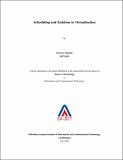| dc.contributor.advisor | Chaudhary, Sanjay | |
| dc.contributor.author | Somani, Gaurav | |
| dc.date.accessioned | 2017-06-10T14:37:45Z | |
| dc.date.available | 2017-06-10T14:37:45Z | |
| dc.date.issued | 2009 | |
| dc.identifier.citation | Somani, Gaurav (2009). Scheduling and isolation in virtualization. Dhirubhai Ambani Institute of Information and Communication Technology, xi, 56 p. (Acc.No: T00197) | |
| dc.identifier.uri | http://drsr.daiict.ac.in/handle/123456789/234 | |
| dc.description.abstract | Virtual machine (VM) based server implementation is popular for numerous advantages like fault isolation, efficient hardware utilization, security and ease of management. Virtual machine monitor (VMM) like Xen is a popular virtualization software to manage virtual machines by scheduling them to use resources such as CPU, memory and network. Performance isolation is desirable in virtual machine based infrastructures to meet Service Level Objectives (SLO). In performance isolation, no virtual machine should affect performance of other co hosted virtual machine, which shares the same hardware. Virtual machine schedulers are the key operators in allocating resources among virtual machines. This requires special attention towards scheduling as fairness and resource isolation are the key requirements for which any user virtualizes servers. I/O models are the main bottlenecks in sharing resources among virtual machines. To evaluate isolation property, we need to analyze resource sharing and utilization among virtual machines.
<p/>The thesis aims to evaluate the performance isolation achieved by Xen in different scheduler configurations. Experiments are performed using different resource intensive applications to get an insight into isolation. These tests include CPU, Network and Disk I/O intensive benchmarks. Considering the equal importance of I/O applications in virtualized environment, tests for interactive applications in conjunction with CPU intensive applications are also performed. Experiment results show that Isolation is critical when we run I/O application in conjunction with CPU intensive applications. But effective parameter and scheduler configuration can lead towards better isolation as well as utilization. Global balancing of load across all the available physical processors in a physical machine is important characteristic of a scheduler. Xen’s Credit scheduler aims to achieve global load balancing on multiprocessor systems. Xen’s Simple Earliest Deadline First (SEDF) scheduler can not be used in production environment due to unavailability of this important feature of load balancing. Many applications requires scheduler like SEDF in their implementation to fulfill the requirement of interactive applications. This thesis investigates requirements of this feature and discusses algorithmic design and implementation of a developed user space load balancing program. Experiments show a balance among number of physical processors with better utilization of | |
| dc.publisher | Dhirubhai Ambani Institute of Information and Communication Technology | |
| dc.subject | Virtual computer systems | |
| dc.subject | Virtual LANs | |
| dc.subject | VMware | |
| dc.subject | Client server computing | |
| dc.subject | Computer organization | |
| dc.subject | Electronic data processing | |
| dc.subject | Distributed processing | |
| dc.subject | Parallel processing | |
| dc.subject | Electronic computers | |
| dc.subject | Real-time data processing | |
| dc.subject | User interfaces & operating systems | |
| dc.classification.ddc | 005.43 SOM | |
| dc.title | Scheduling and isolation in virtualization | |
| dc.type | Dissertation | |
| dc.degree | M. Tech | |
| dc.student.id | 200711003 | |
| dc.accession.number | T00197 | |

